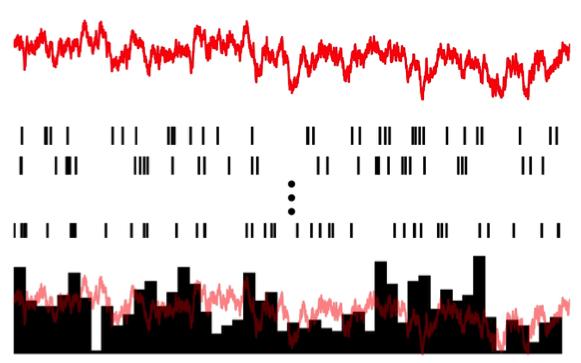Applications and limitations of linear response functions in models of neural circuits

The stimulus (red trace) produces a spiking response within its neurons (thin black bars). Within linear response theory, the neuronal response is a frequency-filtered version of the stimulus. Herfurth/ Tchumatchenko (Max Planck Institute for Brain Research)
Tim Herfurth and Tatjana Tchumatchenko from the Theory of Neural Dynamics Group (Max Planck Institute for Brain Research) now dive into the wide variety of applications and the limitations of these models and discuss why alternatives are needed and what they may be.
Linear response functions were originally developed to understand phenomena in physics and have become an important tool in neuroscience. They lead to deeper insight into diverse areas of neuroscience such as rate dynamics, synchrony, global oscillations, and information theory.
Herfurth: “Linear response functions have been applied to successfully predict the firing activity for a given sensory stimulus, e.g. the response of a retina to a light stimulus. These functions were also useful in determining when and how neurons will synchronize or how much information they transmit”.
However, the linear response concept is now facing its limitation because it was originally developed for systems which fulfill certain stationarity criteria or which are subject to weak stimuli. For many processes in the brain, these do not apply and functions such as classification, adaptation or stimulus-dependent normalization require additional nonlinear contributions.
Tchumatchenko: ”The linear response theory makes predictions only about firing rates but not about changes in spike timing coordination, which is considered a fundamental unit of neural computation. One way to overcome these limitations is to add non-linearity and feedback loops”.
Publication: Herfurth, T. and Tchumatchenko, T. (2017). How linear response shaped models of neural circuits and the quest for alternatives. Curr Opinion in Neurobiology 46: 234-240.
http://www.sciencedirect.com/science/article/pii/S0959438817300144
Media Contact
More Information:
http://www.brain.mpg.de/All latest news from the category: Life Sciences and Chemistry
Articles and reports from the Life Sciences and chemistry area deal with applied and basic research into modern biology, chemistry and human medicine.
Valuable information can be found on a range of life sciences fields including bacteriology, biochemistry, bionics, bioinformatics, biophysics, biotechnology, genetics, geobotany, human biology, marine biology, microbiology, molecular biology, cellular biology, zoology, bioinorganic chemistry, microchemistry and environmental chemistry.
Newest articles

High-energy-density aqueous battery based on halogen multi-electron transfer
Traditional non-aqueous lithium-ion batteries have a high energy density, but their safety is compromised due to the flammable organic electrolytes they utilize. Aqueous batteries use water as the solvent for…

First-ever combined heart pump and pig kidney transplant
…gives new hope to patient with terminal illness. Surgeons at NYU Langone Health performed the first-ever combined mechanical heart pump and gene-edited pig kidney transplant surgery in a 54-year-old woman…

Biophysics: Testing how well biomarkers work
LMU researchers have developed a method to determine how reliably target proteins can be labeled using super-resolution fluorescence microscopy. Modern microscopy techniques make it possible to examine the inner workings…





















